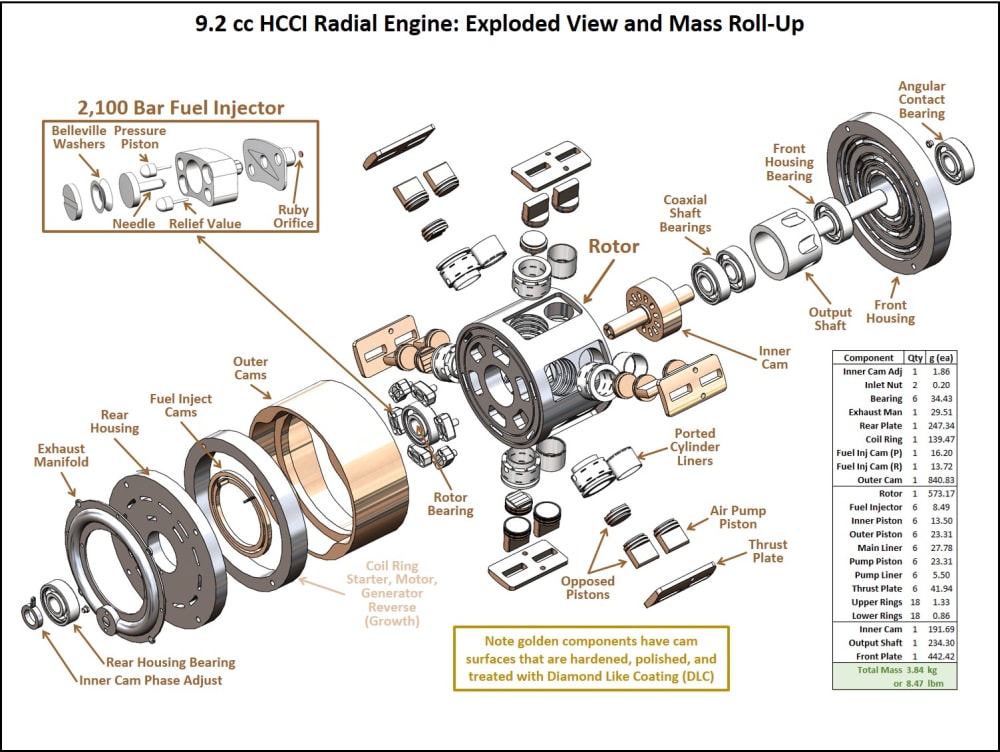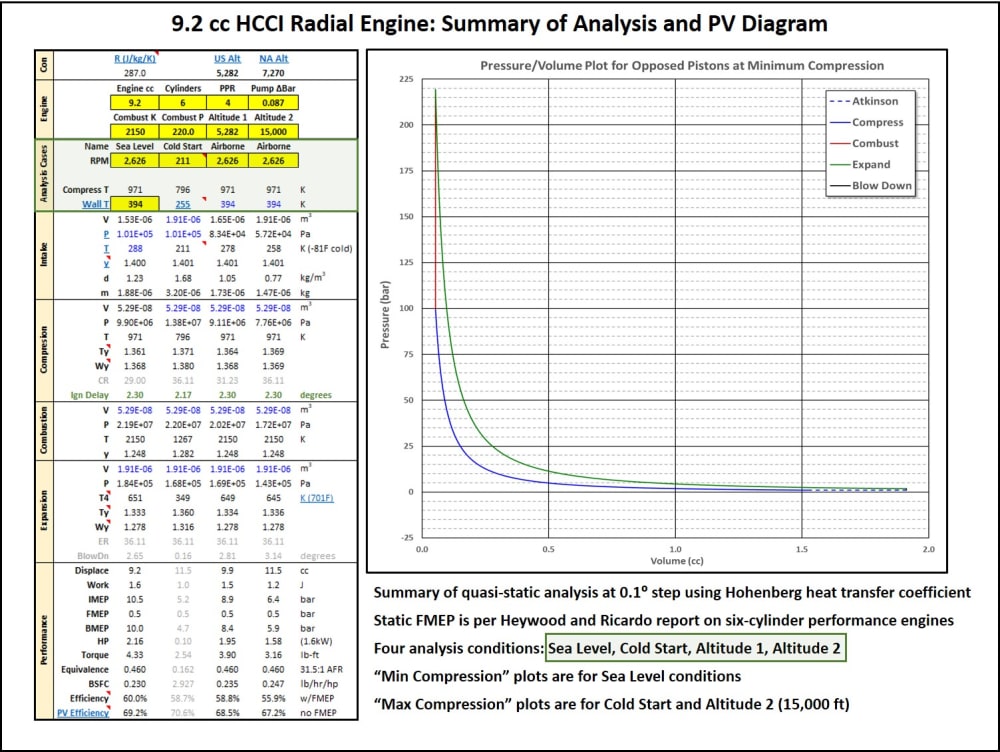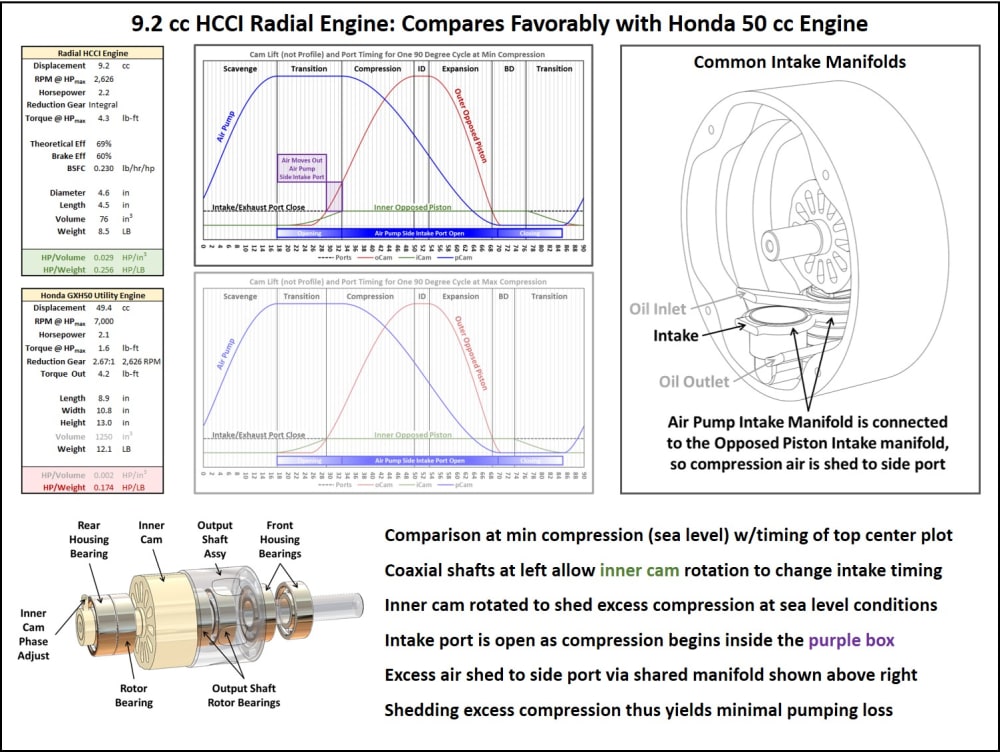Clean air is better than dirty air, so it’s wise to reduce emissions. It will take decades to deploy sufficient infrastructure to eliminate internal combustion, however. By the time it’s completed, advances in engineered and bio-fuels will reduce emissions sufficiently to keep internal combustion relevant. This submission summarizes an engine that reduces emissions of lawn tools, off-road vehicles, scooters, generators, range extenders, and light aircraft collectively responsible for millions of tons of annual emissions.
The engine is designed for full time operation of Homogeneous Charge Compression Ignition (HCCI) in the Low Temperature Combustion (LTC) regime for improved efficiency and reduced emissions when fueled by canola oil, (bio)diesel, or JP-8. The key design decisions and features listed below are tagged per the motivating factor or resulting feature. Driving decisions are tagged “HCCI” and “Efficiency”; those labeled “Fix” address shortcomings in the resulting approach; those labeled “SWAC” relate to Size, Weight, and Cost. The rest are self-explanatory.
- Radial configuration eliminates cold end cylinders, reduces temperature variance (HCCI).
- Plethora of small bore pistons tolerate extreme loads of explosive combustion (HCCI).
- Variable compression for stable ignition delay over load and temperature (HCCI)
- Cam drive allows rapid compression with pause at peak for chemical kinetics (HCCI)
- Opposed pistons reduce combustion chamber surface area and heat loss (Efficiency)
- Two stroke operation for large port area in small bores (Efficiency).
- Separately timed scavenge pump moves air at low pressure and pumping loss (Efficiency).
- Rotor facilitates later incorporation of an integral motor/generator (Efficiency, SWAC).
- Centrifugal force recovers oil leaving ports (issue in opposed-piston two-strokes) (Fix).
- Highly polished steel cams and followers with Diamond Like Coating (DLC) (Fix).
- Radial with opposing cylinders yield harmonic balance of complex forces (Fix, Vibration).
- Six cylinder sets, four cycles per rotation, 24 power strokes per revolution (Vibration).
- Cams enable four power strokes per revolution yielding a 4:1 reduction gear (SWAC).
- Centrifugal force replaces discrete pumps for fuel, oil, and coolant. (SWAC, Reliability)
- Cam driven fuel injectors eliminate single point failures in fuel system (Reliability).
- Only a simple two-way exhaust catalyst required (no soot filter or NOx adsorber) (SWAC).
- Cam radius, contact area, and surface speed increase with engine displacement (Scaling).
- Excess compression for cold start allows sustained performance at altitude (Feature).
An affordable 9.2 cc prototype is planned to demonstrate performance. Math model predictions summarized in the figures compare favorably to a Honda 50 cc engine. The performance shown is associated with operation at sea level, compression ratio of 29:1, 10 bar BMEP, peak combustion pressure of 220 bar (preventing ignition of lubricating oil), and peak combustion temperature of 2150K (inhibiting NOx production).
The engine concept and design are complex and subtle, yet the accompanying video shows the mechanical apparatus and its operation to be simple and elegant. The manufacturing cost is expected to be low due to high reuse of comparatively few unique components.
Video
Like this entry?
-
About the Entrant
- Name:Roderick Newstrom
- Type of entry:individual
- Software used for this entry:Excel and Solidworks (CAD, FEA, CFD, Motion)
- Patent status:pending








